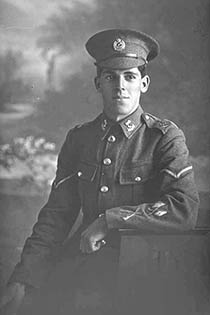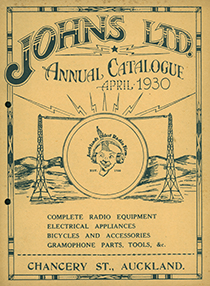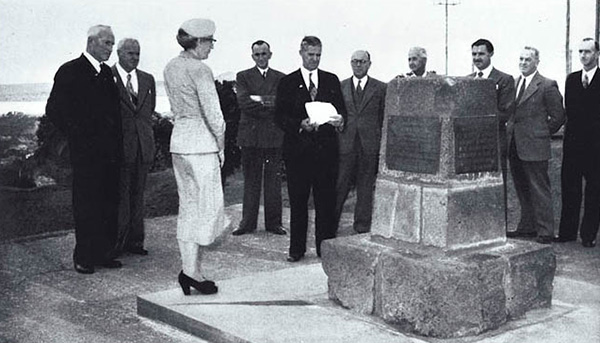‘Had the wound been at all serious I would have cabled at first opportunity but being slight I didn’t think it necessary… I hope none of the false reports have reached you... I’ll try not to get hit next time and save all this trouble.’
Clive Johns to sister Ada, 29 June 1917. MS Papers 11253-33, Alexander Turnbull Library, Wellington.
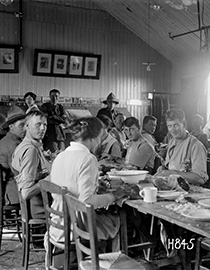
A YMCA canteen at the New Zealand Infantry and General Base Depot Etaples where Johns recuperated in 1917.Ref: 1/2-013426-G. Alexander Turnbull Library, Wellington, New Zealand.
`At times I get a piercing pain round my lung; whether it will improve when I am up and walking I can’t say, but I can’t take a very deep breath and am afraid to yawn properly.’
Clive Johns to his sister Ada, 26 November 1917. MS Papers 11253-33, Alexander Turnbull Library, Wellington.
In the trenches
It was still foggy when Johns arrived at Sling Camp near Salisbury on the last day of 1916. After further training, he shipped to France in early February 1917 and joined the 1st Battalion, WIR at Pont de Nieppe, near Armentieres.
During April and May, Johns’ unit was based across the border in Belgium patrolling and preparing for the planned offensive to capture the village of Messines. This included digging an extensive new trench system into no man’s land to serve as a starting point for the attack. On the evening of 6 June as his unit assembled for the offensive, Johns noted that ‘everyone looks other than cheery’. At about 10pm, after a cup of tea, they began the long march to the frontline. Their progress was hampered by the ‘large amount of tear gas sent over by Fritz’ and they eventually reached their assembly point at 3am. Their trench was heavily shelled while they waited for their turn to advance. At least four men were killed and several wounded, including Johns.
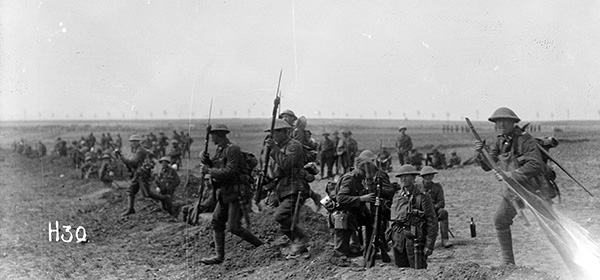 New Zealand Troops training for the attack on Messines, 1917.Ref: 1/2-012754-G. Alexander Turnbull Library, Wellington, New Zealand.
New Zealand Troops training for the attack on Messines, 1917.Ref: 1/2-012754-G. Alexander Turnbull Library, Wellington, New Zealand.
With only a slight wound to his shoulder, Johns helped carry Private Arthur Blair, whose legs were badly injured, to a nearby dressing station where Johns also had his wound dressed. He was transferred to No 2 Stationary Hospital, Abbeville and discharged to the New Zealand Infantry and General Base Depot at Etaples to recuperate. While visiting the YMCA on 27 June, he was stunned to find that he had been listed as killed in action. With the help of an army chaplain, he immediately cabled home that he was `quite well’.
We can only imagine the emotional turmoil the Johns family went through after receiving the news that Clive was dead and then 10 days later learning that he was alive and well. His elder brother William, serving with the Auckland Mounted Rifles in Palestine, greeted the news of Clive’s death with disbelief: `I got the cable last night’, he wrote to his parents, `and it was that unexpected that I don’t think I realise it yet... I never really thought of him being in the firing line’. When he heard his brother was safe, an ecstatic William shouted drinks in the Mess to celebrate. The family’s happiness was short-lived. On 19 October during the third battle of Ypres, Clive was wounded again, this time seriously, and on 31 October William was killed at Beersheba.
Johns received multiple wounds to his chest, right arm, thigh and leg when he ‘got mixed up with a shell which landed too close to be comfortable’. Near death, he was admitted to the No 44 (Canadian) Casualty Clearing Station where surgeons operated on his chest wounds. He was then transferred by train to No 4 General Hospital. The journey took 30 hours on a stretcher, lying uncomfortably on what Johns later discovered was a piece of shrapnel pressing against his spine.
In November, Johns was evacuated to the Southwark Military Hospital, London for further treatment. Confined to bed, he was visited by members of the New Zealand High Commission and aid workers who brought him toiletries and books. He also received biscuits, chocolate and cake from family in New Zealand ‘none the worse for their four months journey’. Johns handed the biscuits around the ward and slipped the nurse a few chocolates as thanks for being gentle while dressing his wounds.
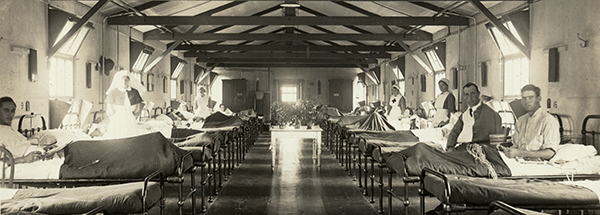 An unidentified ward in No. 1 New Zealand General Hospital, Brockenhurst.Accession 1992.750, National Army Museum Te Mata Toa, Waiouru.
An unidentified ward in No. 1 New Zealand General Hospital, Brockenhurst.Accession 1992.750, National Army Museum Te Mata Toa, Waiouru.
Johns’ recovery was slow and one of his chest wounds was still not completely healed when he was moved to No. 1 New Zealand General Hospital, Brockenhurst in January 1918. He was ruled as unfit for military service and arrangements were made for his return to New Zealand. Johns arrived in Auckland in May where he continued to receive medical treatment as an outpatient at Auckland Hospital. By July, his health had recovered enough to play hockey and attend dances at the Soldiers Club and Teachers’ Training College. Johns was discharged from the military in August and in October, a year after being wounded, returned to work at L.D. Nathan.



